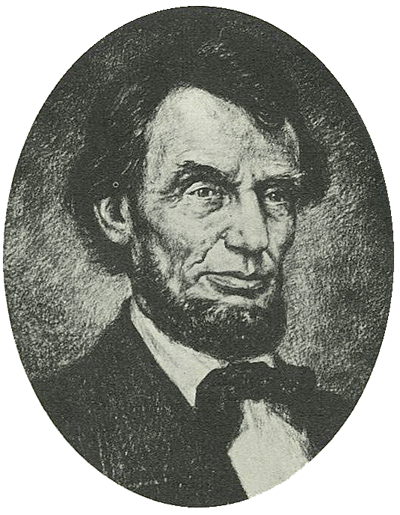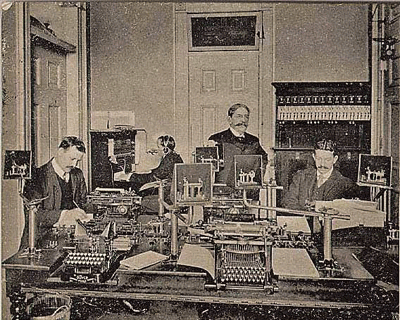Chief Copy Editor
In his book Killing Lincoln , Bill O’Reilly says that President Abraham Lincoln was “addicted to T-mail.” T-mail is O’Reilly’s device to modernize telegrams, which today are outdated, but in the early 1860s, at the time of the Civil War, they were the fastest way to communicate.
The telegraph was invented by Samuel F.B. Morse in 1844, creating a practical use for a still-earlier invention, the electromagnet, by British inventor William Sturgeon in 1825. Of course, Morse had plenty of scientific research to draw upon (see box, “The Telegraph’s Who’s Who” at the end of this article).

Abraham Lincoln used the telegraph in a big way during the Civil War.
But it was Morse who made the telegraph a success. His system, initially a wire strung between Washington, DC, and Baltimore, MD, carried political news from its beginning, reporting in May 1844 that the Whig Party had nominated Henry Clay to run run for President that year. This initial telegraph line was Federally funded, but the $30,000 the line cost was not granted in 1838 when the system was ready but six years later. People were simply not yet ready to be addicted to T-mail.
When the line was actually completed, it was officially opened with the message “What hath God wrought?” (from Numbers 23:23), sent from the Supreme Court building in Washington to Baltimore. The message was sent in the code that Morse invented, although the original American Morse Code was different than the International Morse Code, adopted in 1865, the series of dots and dashes that we know today.
Morse and his associates obtained private funds to extend their line to Philadelphia and New York. Small telegraph companies, meanwhile, began functioning in the East, South, and Midwest. Dispatching trains by telegraph started in 1851, the same year Western Union began business. Western Union built its first transcontinental telegraph line in 1861, mainly along railroad rights-of-way.
The Civil War of 1861-1865 required a new communication system for use by the government and the armed forces. President Lincoln was already very much aware of the value of the telegraph. When he was President-elect and arrived in Washington in 1861, the telegraph had been around for 17 years, but the agencies of government were flummoxed over how to use it. When the Army wanted to send a telegram, for instance, it sent a clerk to stand in line at Washington’s central telegraph office, a public facility. There was no telegraph station at the White House, the War Department, the Navy Yard, or any other vital government installation.
Lincoln saw his first telegraph key only three years before he ran for president, in a hotel lobby while riding circuit in Pekin, IL. Always fascinated with technology, he peppered the operator with questions. Lincoln’s fascination with new technology was evident: He is the only President to be granted a patent (in 1849, he invented a hydraulic device which lifted ships over shoals). He approved the use of the latest in weaponry, which probably made the Civil War the bloody conflict that it was. He promoted the military use of hot air balloons. He had paved the way for the completion of the first transcontinental railroad in 1869.
As President, he ordered a system of wires to be run throughout the northern states to connect all areas. Some areas would be covered by quickly-set-up poles and wires by use of wagons, horses and men. The telegraph equipment would be portable. Lincoln’s “addiction to T-mail” was evident: The telegraph allowed Lincoln to take personal command of the battlefronts. Although the White House never had telegraph wiring, the nearby War Department building did. The President spent hours in the telegraph office waiting for and sending messages.

Lincoln visited the telegraph office in the War Department daily.
The messages were, of course, coded to hide them from the Confederacy. Since telegraphers could send and receive American Morse Code very fast, everyone could read everyone else’s messages, so ciphering and deciphering were necessary.
Quite a lot is written about Lincoln’s visits to the telegraph room at the War Department. The use of telegrams was just beginning in the 1860s. Long after Lincoln’s assassination on April 14, 1865, telegrams were still popular. They reached their peak popularity in the 1920s and 1930s when it was cheaper to send a telegram than to place a long-distance telephone call. People would save money by using the word “stop” instead of periods to end sentences because punctuation was extra while the four-character word was free. The last telegram was sent in February 2006. ■
Box: The Telegraph’s Who’s Who
A Who’s Who of scientists studying electricity had a hand in developing the telegraph over a period of about 100 years. Electricity was known to travel quickly, so using it to send messages over great distances was a goal of many experimenters. All the known effects of electricity — such as sparks, electrostatic attraction, chemical changes, electric shocks, and later electromagnetism — were applied to the effort.
• In 1746 the French scientist and abbé Jean-Antoine Nollet connected about two hundred monks in a circle about a mile in circumference, with pieces of iron wire and sent an electric shock through the human chain. He observed that they all reacted to the shock at approximately the same time.
• As early as 1753 an electrostatic telegraph was envisioned, using one wire for each letter of the alphabet to send a message. Telegraphs employing electrostatic attraction were the basis of early experiments in electrical telegraphy in Europe, but were abandoned as being impractical and were never developed into a useful communication system.
• In 1800 Alessandro Volta invented the Voltaic Pile, allowing for a continuous current of electricity for experimentation. This became a source of a low-voltage current that could be used to produce more distinct effects, and which was far less limited than the momentary discharge of an electrostatic machine, which with Leyden jars were the only previously known manmade sources of electricity.
• In 1809 Samuel Thomas von Sömmering in Germany created the electrochemical telegraph, expanding on the 1804 work by Francisco Salva Campillo of Spain. Both designs employed multiple wires (up to 35), immersed in acid, to represent almost all Latin letters and numerals. The main disadvantage to the system was prohibitive cost, due to having to manufacture and string-up the multiple wire circuits it employed, as opposed to the single wire (with ground return) used by later telegraphs.
• In 1816 Francis Ronalds set up a primitive telegraph over eight miles using static high-voltage electricity. At both ends there were clockwork operated dials with numbers and letters of the alphabet.[5]
• In 1820 Hans Christian Ørsted discovered that an electric current produces a magnetic field which will deflect a compass needle. In the same year Johann Schweigger invented the galvanometer, with a coil of wire around a compass, which could be used as a sensitive indicator for an electric current.
• In 1821 André-Marie Ampère suggested that telegraphy could be done by a system of galvanometers, with one wire per galvanometer to indicate each letter, and said he had experimented successfully with such a system, but in 1824, Peter Barlow said that such a system only worked to a distance of about 200 feet, and so was impractical.
• In 1825 William Sturgeon invented the electromagnet, with a single winding of uninsulated wire on a piece of varnished iron, which increased the magnetic force produced by electric current.
• In 1828 Joseph Henry improved Sturgeon’s electromagnet by placing several windings of insulated wire around the bar, creating a much more powerful version that could operate a telegraph through the high resistance of long telegraph wires.
• In 1832 an electromagnetic telegraph was created by Baron Schilling in Russia, and in 1833 Carl Friedrich Gauss and Wilhelm Weber invented their own code to communicate over a distance of 1,200 meters within Göttingen, Germany.
• In 1835 Joseph Henry invented the critical electrical relay, by which a weak current could operate a powerful local electromagnet over very long distances.
• In 1836 an American scientist, Dr. David Alter , invented the first known American electric telegraph, in Elderton, PA, one year before the Morse telegraph, but it was never developed into a practical system.
• In 1837 Sir William Fothergill Cooke and Charles Wheatstone developed the first commercial electrical telegraph, patented as an alarm system and used for messages in London, England.
And then Samuel F.B. Morse “invented” the telegraph, with all this help. ■
Sources
Bill O’Reilly and Martin Dugard, Killing Lincoln: The Shocking Assassination That Changed America Forever (Thorndike Press, Waterville, ME, 2011). Also: Tom Wheeler, Mr. Lincoln’s T-Mails (2008).
http://inventors.about.com/od/tstartinventions/a/telegraph.htm
http://en.wikipedia.org/wiki/Electrical_telegraph
http://www.alincolnlearning.us/Civilwartelegraphing.html
http://opinionator.blogs.nytimes.com/2012/05/24/the-first-wired-president/
http://wiki.answers.com/Q/Who_was_the_only_US_president_ever_granted_a_patent#ixzz22UjmIdow)
http://www.historyplace.com/lincoln/
http://www.mediapost.com/publications/article/100248/the-first-telecom-president.html?print
http://www.mrlincolnswhitehouse.org/inside.asp?ID=630&subjectID=4
The images of the Presidents, from Washington to Eisenhower, in this series are from a little book I got from my mom when I was less than 10 years old. Simply titled Presidents of the United States , this book began my interest in the Presidents. I think it came from an insurance company, but I can't find a publisher listed in its pages. See http://www2.electronicproducts.com/How_I_got_interested_in_Presidential_history-article-fals_president_start_aug2012-html.aspx
Advertisement
Learn more about Electronic Products Magazine





